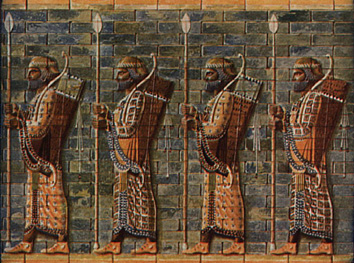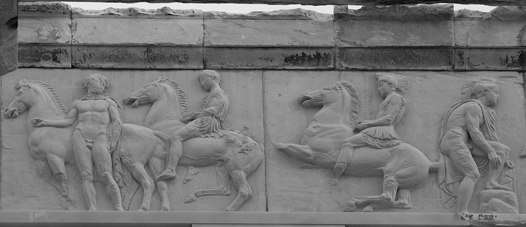ARMA
Editorial - May 2012
Our Holistic Approach to Research and Study
By Chrysovalantis Tampakakis
ARMA Scholar Adept, Athens, Greece
As I was studying some photos of friezes from famous ancient temples
and palaces, I noticed some differences between two of them, which so
accurately represent the differences in ideology and philosophy between
two different cultures. The two civilizations were Greek and Persian,
which in the past came to solve their differences on the Marathon field
of battle, when the one unsuccessfully tried, through war and conquest,
to enforce its beliefs and dominate the other. The differences I noted
were tellingly profound.
 In
the first photo (pic 1), we see a frieze of glazed bricks from Darius'
palace at Susa that depicts some Persian soldiers. All of them are standing
on the very same stance, they have exactly the same haircut, their weapons
are identical and even the colors and patterns of their garments are 'repeated
to infinity.' It is like someone has copy-pasted the figure of one single
person in the whole frieze. This kind of Persian Imperial Art, (where
materials and artists were drawn from all corners of the empire, but the
result fails to show variety, shows no respect towards a person's individuality
and still remains monotonous), mirrors the Persian understanding of how
the empire ought to function. In
the first photo (pic 1), we see a frieze of glazed bricks from Darius'
palace at Susa that depicts some Persian soldiers. All of them are standing
on the very same stance, they have exactly the same haircut, their weapons
are identical and even the colors and patterns of their garments are 'repeated
to infinity.' It is like someone has copy-pasted the figure of one single
person in the whole frieze. This kind of Persian Imperial Art, (where
materials and artists were drawn from all corners of the empire, but the
result fails to show variety, shows no respect towards a person's individuality
and still remains monotonous), mirrors the Persian understanding of how
the empire ought to function.
In the second photo (pic 2), we see a marble frieze from the temple of
Parthenon in Athens, that depicts the Athenian cavalry taking part in
the festival of Panathenaia. Every cavalier and also every single horse
are unique. We can see many different stances, many different garments
and armors; some horses are standing still while others are galloping,
each of them in its own unique way. And when we watch this frieze from
a distance we see nothing chaotic, but a harmonic, unique, marvelous piece
of Art with perfect proportions. A mirror of the Greek understanding of
how the Athenian democracy ought to function. Strong individuals, so much
different from each other, who nevertheless coexist and collaborate harmoniously.
And even if they might not share the same origins; even if each one of
them had a personal, unique way to express himself, altogether they formed
one city, one nation, sharing the same cultural background and following
the same virtues and fundamental principles. A hymn to individuality and
dissimilarity. A paradigm of how civilization ought to be and, surely,
how our study approach to Mare (the martial arts of Renaissance Europe)
ought to be.

Today, all the aficionados of the Art have the chance to study the works
of many different authors and masters, which derived from different countries
and had different methods and approaches; but nonetheless their combat
styles derived from a single basis. It is true that most of our sources
come from German and Italian masters like Sigmund Ringeck, Hans Talhoffer,
Fiore dei Liberi, Philippo Vadi, and Joachim Meyer, but this can in no
way prove that this martial art was of German or Italian origin. And it
is really very sad when I see that some people try to make ethnological
or nationalistic claims on the Art today. I do not need to say that no
nationality or ethnic group can "own" the Art or its surviving
teachings (a very good answer on this subject has already been given here:
The
Intangible Cultural Heritage of Martial Traditions). But allow
me to add the following:
It is true that many of these fight-masters of the past not only have
traveled and studied the Art in many different European lands before they
synthesized and created a system of their own, but also their accomplishments
were their personal systems and methods that no one can prove were
wide spread. Sigmund Ringeck's and Hans Talhoffer's Fechtbucher do not
prove that all German men-at-arms or knights in general were accomplished
Fechtmeisters. They only prove that Hans and Sigmund themselves, and probably
some of their students, were great martial artists.
Also, to have in our hands the works of Germans, Italians, English, Dutch,
and Spaniards does not mean that the Art of Fighting was unknown to other
nations. Martin Siber in his 'Fechtlehre' of 1491 says that in
his time there were many accomplished sword-masters; 'goodly masters:
from Hungary, Bohemia, Italy; from France, England and Alemania; from
Russia, Prussia, Greece, Holland, Provence and Swabia'. I would not be
surprised if in the years to come we discovered any fight-book written
in Greek, Russian or Magyar. So, is our fighting art German? Italian?
Roman? Greek? Bohemian? No, rather a great synthesis of all the above.
That is why we describe this martial art with the generic term "Renaissance"
and that is why the ARMA study approach and system is ideally a holistic
one.
I can find no meaning in the study approaches of some modern schools
of Medieval and Renaissance close combat that strictly focus narrowly
on the works of a single master or a couple of masters that were of same
nationality or origin. This approach brings to my mind the 'claustrophobic',
monotonous pattern of the Persian frieze with the Immortals. Fiore-Fiore-Fiore-Fiore
or Mair-Meyer-Mair-Meyer. I prefer the open-minded study approach of ARMA
and its broadly sourced training program and methodology, that so much
reminds me of this Parthenon frieze. Ringeck-Vadi-Meyer-Fiore-Agrippa-Silver-Fabris…
Armatura.
But you can say that this is just my opinion and my point of view. What
makes no sense at all, to me, is when people resort to ironic comments,
such us: 'Well, ARMA is an American organization and as I see there are
also some groups in Greece and Mexico or Poland. How can people from these
countries claim they have knowledge of these lost and forgotten German
and Italian combatives from the Renaissance era?' First of all, even if
these arts were indeed the sole heritage of certain modern nations, the
wisdom of the past should be common domain to all. It would be as silly
for a modern German from Strasburg to try to prove he has the copyright
of the works of the 16th century fight-master Joachim Meyer, claiming
that he is a direct descendant of this teacher, as it would be for an
Athenian Greek to try to prove he owns the copyright of the works of Plato,
because argues he has the same origins as the philosopher.
When, back in 2003, I was looking for a martial arts school or organization
so that I could learn the 'secrets' of this craft, I never sought to find
one specifically in 'the lands where the Art was born'. I just sought
the best and most accomplished teacher in the Art. My criteria were not
ethnocentric and I never cared about an instructor's citizenship or national
origins. What I was looking for was real skill and serious academic research.
Just having a look in the ARMA's vast online materials and watching the
unmatched performances of its senior teacher and students in the video
section, was more than enough for me. Just like when I was looking for
a good Lexicon of the ancient Greek language I sought for the best and
found the magnificent work of H.G.Liddell and R.Scott. It never troubled
my mind that the authors were of British and not Greek origin; I only
cared that their work was (and still is) considered monumental for decades
by students and teachers of the Greek language from every corner of this
world. And to support my opinion that 'skills matter more than origin',
I would like to share a famous quote with all:
'The study of arts, as well as the philosophy that has
to do with oratory, would make the greatest advance if we admired and
honored, not those who made the first beginnings in their crafts, but
those who are the best and the most accomplished craftsmen in each.'
- Isocrates (436-338 BC) from his Panegyricus Speech
|

